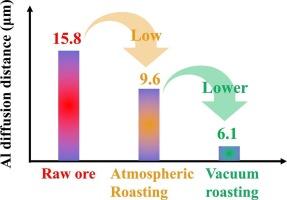真空焙烧抑制了白云母杂质中铝在焙烧过程中向石英中的扩散
IF 5
2区 工程技术
Q1 ENGINEERING, CHEMICAL
引用次数: 0
摘要
现有的去除石英金属杂质的研究主要集中在提高矿物杂质的暴露度和反应活性上。但未考虑焙烧过程中矿物杂质对石英结构的影响。采用理论分析和电池参数对比的方法,研究了白云母杂质对焙烧过程中石英结构的影响。发现白云母中的铝(Al)在焙烧过程中扩散到石英中,形成晶格杂质,阻碍了石英的提纯。采用Arrhenius方程和石英-白云母扩散偶联实验研究了抑制扩散的方法。结果表明,降低石英中H2O的含量可以有效抑制Al的扩散行为。在此基础上,引入真空焙烧工艺来提高石英中H2O的脱除效果。实验结果表明,在相同条件下,真空焙烧使石英中H2O含量由165.9 μg·g−1降至37.8 μg·g−1。这使得Al的扩散距离从15.8 μm减小到6.1 μm。最后,通过数据分析,得出焙烧过程中水浓度与Al扩散系数的函数关系为D=D0CH2O1.310exp-ΔHRT。本研究阐明了矿物杂质在焙烧过程中对石英结构的影响,为石英的提纯提供了新的解决方案,也为优化石英及其他矿物的提纯工艺提供了参考。本文章由计算机程序翻译,如有差异,请以英文原文为准。

Vacuum roasting inhibited the diffusion of aluminum in muscovite impurities into quartz during roasting process
Existing research on removing metal impurities from quartz mainly focuses on enhancing the exposure and the reactivity of mineral impurities. However, the influence of the mineral impurities on the quartz structure during roasting is not considered. In this study, the influence of muscovite impurities on the quartz structure during roasting was studied using theoretical analysis and cell parameter comparison. It was found that aluminum (Al) in muscovite diffused into the quartz during roasting and forming lattice impurities, hindering the purification of quartz. Arrhenius equation and quartz-muscovite diffusion couple experiments were employed to investigate the method of inhibiting diffusion. And it was concluded that reducing the H2O content in quartz can effectively inhibit the diffusion behavior of Al. Based on the above research, vacuum roasting process was introduced to enhance the removal of H2O in quartz. The experimental results shown that under the same conditions, vacuum roasting reduced the H2O content in quartz from 165.9 μg·g−1 to 37.8 μg·g−1. This led to the reduction of the diffusion distance of Al from 15.8 μm to 6.1 μm. Finally, through data analysis, the functional relationship between water concentration and Al diffusion coefficient in roasting process is . This study clarifies the influence of mineral impurities on the structure of quartz during roasting, which provides a new solution for the purification of quartz and a reference for optimizing the purification process of quartz and other minerals.
求助全文
通过发布文献求助,成功后即可免费获取论文全文。
去求助
来源期刊

Minerals Engineering
工程技术-工程:化工
CiteScore
8.70
自引率
18.80%
发文量
519
审稿时长
81 days
期刊介绍:
The purpose of the journal is to provide for the rapid publication of topical papers featuring the latest developments in the allied fields of mineral processing and extractive metallurgy. Its wide ranging coverage of research and practical (operating) topics includes physical separation methods, such as comminution, flotation concentration and dewatering, chemical methods such as bio-, hydro-, and electro-metallurgy, analytical techniques, process control, simulation and instrumentation, and mineralogical aspects of processing. Environmental issues, particularly those pertaining to sustainable development, will also be strongly covered.
 求助内容:
求助内容: 应助结果提醒方式:
应助结果提醒方式:


